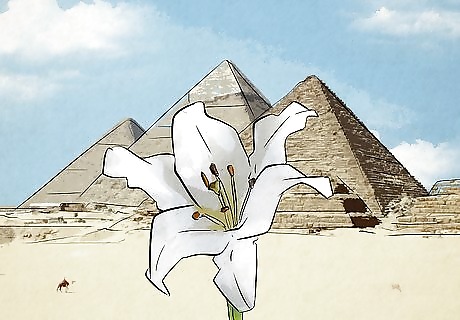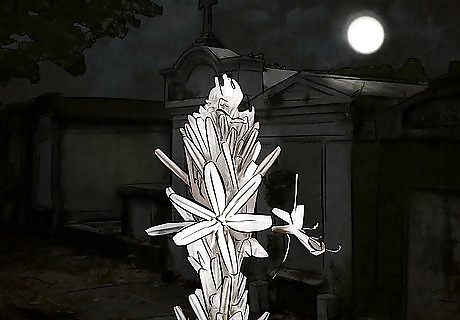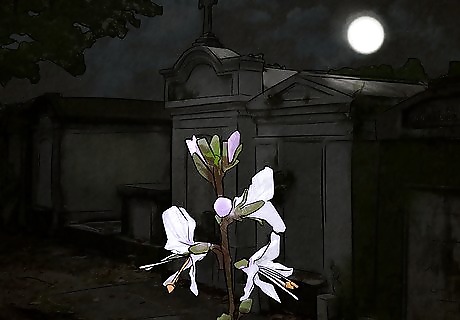
views
- Flowers commonly used in funeral arrangements or sympathy bouquets include carnations, orchids, lilies, and gladioli.
- Not every flower that symbolizes death can be used to express condolences. Some express danger or ill will, and their meaning may vary by culture.
- A flower’s modern symbolism is typically connected to its appearance in religious texts, mythology, or the famed Victorian-era flower code.
Carnation

Carnations symbolize love and remembrance. Their connection to death comes from their frequent use in funeral arrangements or as sympathy gifts to those who’ve lost a loved one. White, dark red, and pink carnations are particularly apt for mourning as they symbolize remembrance, deep love, and a mother’s loss. The maternal meaning of a pink carnation originates from the Christian crucifixion story, where the flowers were said to spring up from Mary’s tears as she mourned her son Jesus. Many countries use carnations to honor veterans and the working class, particularly on International Workers’ Day (May 1). White carnations are worn in the Netherlands to remember the World War II resistance, while the Portuguese use bright red carnations to represent the 1970s Revolution of the Carnations.
Chrysanthemum

Chrysanthemums symbolize comfort during times of sorrow. Also known simply as “mums,” they are often placed on gravestones or in floral arrangements for funerals. Their use as gifts to express sorrow is popular throughout Europe and North America, although other cultures have different associations with them. Chinese and Japanese cultures believe that the chrysanthemum represents youth and can allow people to live longer. Japan also boasts the chrysanthemum as their national flower and celebrates it annually at the Festival of Happiness (September 9). The chrysanthemum is also used in Australia as a traditional gift for Mother’s Day or a 13th anniversary.
White Lily

White lilies symbolize purity and innocence. Lilies are often used in flower arrangements at funerals to represent hope and peace for the deceased and their loved ones. This usage is traced back to ancient Egypt and early Christianity, where lilies were drawn on tombs and tombstones to symbolize fertility and rebirth.
Red Spider Lily

Red spider lilies symbolize death, rebirth, and a final goodbye. The red spider lily is especially popular as a funerary flower in Asian cultures, and they are often left in graveyards as a memorial to the deceased. This modern significance is believed to come from the historic Japanese practice of planting the poisonous red spider lily over the grave to keep animals away. For this reason, the red spider lily is sometimes called the “death flower” or “corpse flower.”
Black Rose

Black roses symbolize death and tragedy. While not technically black, the black rose often comes in an intense shade of purple or red. People often dye regular roses black to evoke the gothic mystery and elegance of the black rose. However, black roses are not the best choice for sympathy gifts, as they are closely connected to death's more macabre and tragic aspects. In Victorian-era floriography, black roses symbolize danger, death, farewell and hatred. In the late 20th century, black roses came to be used as a symbol of anarchist political movements in North America, but this symbolism is not widely recognized. Most popularly, black roses appear in media to symbolize farewells, grief, or the end of something significant.
Dried White Rose

A dry white rose symbolizes a preference for death over lost innocence. This intensely emotional meaning dates back to the popular Victorian-era flower code, where these flowers would symbolize someone’s commitment to their virtue above all else. In the present day, dry white roses may offer a moment of reflection and contemplation after a loss. A fresh white rose would be more appropriate when buying flowers for a funeral, as they symbolize peace and purity.
Goldenrod

Goldenrod symbolizes good luck and protection. In the United States, goldenrod has been believed to ward off evil spirits and grant good fortune to whoever receives it. Following the belief that goldenrods may grant someone good luck in the afterlife, these flowers are often used in floral arrangements at funerals, memorials, or other end-of-life ceremonies. In the Victorian-era language of flowers, goldenrod sent the message that someone should be cautious or take care of themselves.
Marigold

Marigolds symbolize the connection between the living and the dead. Marigolds are believed to attract the souls of people who have passed and briefly reunite them with the living, if only in spirit. These vibrant flowers are seen as a celebration of life rather than an acknowledgment of tragic death. Marigolds are most popularly used for Day of the Dead traditions in Latin America, and anywhere pre-Columbian religions are practiced. On the Day of the Dead, or día de muertos, marigolds are placed on the family altars (ofrendas) and scattered in a path from the cemetery to the front door of the home in an attempt to guide spirits on their journeys. The spiritual significance of marigolds comes from Nahuatl mythology, in which the sun god Tonatiuh gifted the flowers to the people as a way to honor their dead.
Daffodil

Daffodils symbolize rebirth and eternal life. This modern interpretation of daffodils likely originates from their connection to Easter and springtime holidays. In medieval times, however, Europeans believed that daffodils were omens of death or misfortune. While not frequently used as a sympathy flower or in funeral arrangements, daffodils may make a fitting tribute when celebrating someone’s life after passing. Their vibrant color may add a touch of joy and life to an otherwise sorrowful occasion.
Red Poppy

Red poppies symbolize consolation and remembrance. They are often used to honor veterans and placed on fallen soldiers' graves. This symbolism came about during World War I to commemorate the sacrifice of those who had fought in the war, originating with the poem “In Flanders Fields” by John McCrae. In countries like the United Kingdom, Canada, France, and Australia, red poppies are worn on Remembrance Day (November 11). In the U.S., red poppies are used on Memorial Day. As funeral arrangements or sympathy gifts, red poppies are best used when the deceased was a veteran or somehow sacrificed for their country during their lifetime. White poppies, on the other hand, represent sleep. While less common, the white poppy can be used to wish a peaceful rest for someone who has passed.
Cypress Vine

The cypress vine symbolizes mourning and lost love. According to Chinese folklore and Victorian-era beliefs, the cypress vine represents past or unrequited love. Victorians even carved the image of a cypress vine onto gravestones to symbolize undying, eternal love. In modern Western culture, cypress vines are often seen as a sign of mourning. They may be especially appropriate as a gift to someone who has lost their spouse or someone they recognize as a soulmate.
Gladiolus

The gladiolus symbolizes sadness and remembrance. Gladioli are often used as funeral flowers to honor the life of whoever has passed. However, the gladiolus also represents strength during grief, making it an appropriate gift when someone has lost a loved one. Ancient Roman gladiators are said to be the namesake for the gladiolus, which was possibly used at the time to remember the fallen gladiators. In Victorian times, however, the gladiolus had a completely different meaning. It was used to convey infatuation between secret lovers and admirers.
Orchid

Orchids symbolize love and unity. Despite not having a direct connection to death, they are often used to convey condolences or express eternal love and affection. Florists often recommend orchids in funeral arrangements or as gifts to express sympathy for someone’s loss. In the United States, white orchids are most commonly used during grieving periods because this culture associates the color white with purity, rebirth, and heaven. In other places, such as China, white represents death and ghosts and should not be used as a gift.
Monkey Orchid

Monkey orchids symbolize darkness, death, and evil. This rare type of orchid is also known as the Dracula Flower, a name alluding to the plant’s dark tendrils that have been compared to a vampire’s fangs. The monkey orchid’s connection with death mostly comes from its off-putting appearance. It’s better to observe this flower from afar than to give to someone who’s experienced a loss.
Rosemary

Rosemary symbolizes remembrance. It is frequently used at funerals, as well as other emotional events like weddings and christenings. While not typically included in floral bouquets, sprigs of rosemary are often carried by or pinned onto the clothing of mourners. The association of rosemary with remembrance was popularized by a line in William Shakespeare’s Hamlet, which was written around 1600. After the play’s success, the connection between rosemary and remembrance was recognized throughout Elizabethan and Victorian England. However, rosemary was used as far back as 1000BC in burial rites and practices, from Ancient Egypt to Ancient Rome.
Wolfsbane

Wolfsbane symbolizes danger and evil. As a plant, it’s poisonous to humans and was used historically to make weapons more deadly—creating an obvious link to death and danger. Due to its negative connotations surrounding death, avoid using wolfsbane as a gift demonstrating sympathy or grief. In Ancient Greek mythology, wolfsbane was created by the monstrous dog said to guard the gates of hell, and it’s also been connected to witchcraft throughout European folklore. Both of these mythological and folkloric associations caused wolfsbane to become a symbol of evil, with Victorians viewing it as a sign of danger and misanthropy.
Rafflesia

Rafflesias symbolize death and trickery. These meanings largely come from the flower’s biological behavior. The Rafflesia is an extremely rare parasitic plant that boasts the largest known individual flower in the world. The flower emits a rotten smell that attracts carrion flies, hence its connection to trickery and deceit. Not only are rafflesias not commercially sold, but their parasitic nature, foul smell, and eerie appearance would not make them an appropriate sympathy gift.
Asphodel

Asphodel symbolizes regret from beyond the grave. Sending an asphodel to a mourner may convey a message of eternal regret or a commitment to faithfulness until death. In the present day, asphodel is often used at funerals or on the anniversary of a loss in order to wish peace for the deceased in the afterlife. Some ancient cultures believed that spirits lived amongst a field of asphodel and so would plant the flower beside tombs and gravestones. This includes Ancient Greeks, who associated the asphodel flowers with death, mourning, and their mythological Underworld.
Anemone

Anemones symbolize remembrance and mourning. In Greek mythology, the anemone plant was said to spring forth from Aphrodite’s tears as she mourned the death of her mortal lover, Adonis. In connection to this lost love, anemone flowers are sometimes used today to honor those who have left us or to express condolences to a person in mourning. In Japanese culture, however, the anemone is a symbol of bad luck, so it would not be an appropriate sympathy gift for someone with a Japanese cultural background.
Cowslip

Cowslips symbolize birth, death, and a pathway to the spiritual world. In Irish and Welsh folklore, cowslips are believed to have the power to open the gateway to the realm of fairies. In funeral settings, cowslips may be appropriate to indicate someone’s believed passage from the physical world to the spiritual one.
Enchanter’s nightshade

Enchanter’s nightshade symbolizes trickery and darkness. This flower has long been associated with sorcery and witchcraft. Despite its strong symbolic connection to death, enchanter’s nightshade is not generally appropriate for mourning purposes. Enchanter’s nightshade is most famously connected to Circe. Circe, the Greek goddess of magic, is thought to have used enchanter’s nightshade in an act of vengeance where she turned men into swine. Due to this mythological connection, the plant is known by the Latin name Circea.



















Comments
0 comment